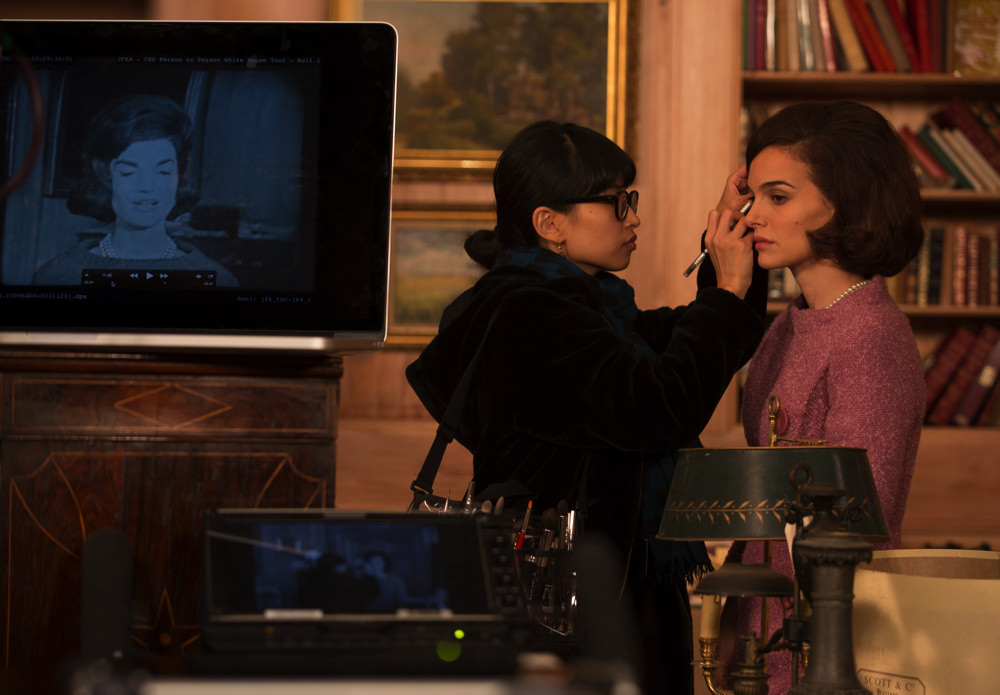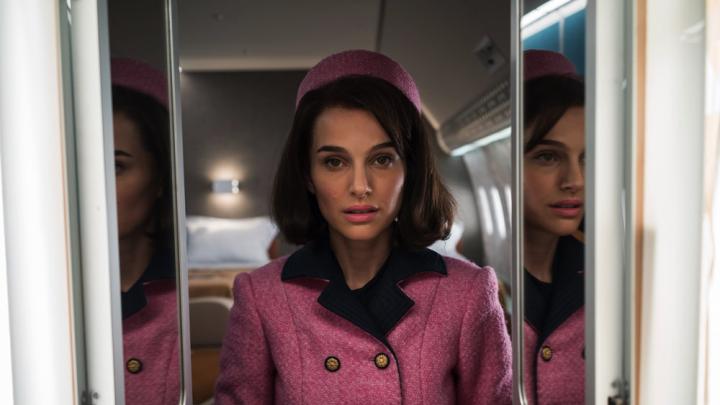It might be impossible to make original art about the Kennedys. A writer could be intimidated by the speculative accounts of President John F. Kennedy’s assassination as penned by Norman Mailer, Don DeLillo, and Stephen King. A movie director may feel compelled to reenact the famous photographs of November 22, 1963, in living color: the First Lady in pink, her arms full of red roses; Lyndon B. Johnson taking the oath. Famously, the Kennedys are credited with making politics telegenic. Less famously—but tellingly—they had a hand in Hollywood: see PT 109, the first commercial biopic of a president still in office, and over which the family had full creative control. And even in the age of viral video, the Zapruder film remains the most famous home movie of all time.
Even taken on her own, Jacqueline Kennedy poses a particular challenge. Painter Gerhard Richter paid tribute to her image in oils; Andy Warhol obsessed over it in silkscreen. An actress has to master her slippery cadences, and match her screen presence, while making her off-screen moments seem psychologically plausible. Many have tried. Jackie has been played by Ginnifer Goodwin and Katie Holmes, by Jaclyn Smith and twice by Jacqueline Bisset; she’s been impersonated satirically by Parker Posey, profanely by Divine.
The new film Jackie approaches its subject, the newly widowed First Lady, by going behind the scenes of Kennedy iconography. Screenwriter Noah Oppenheim ’00 credits the earliest inspiration for the film to his mother: “She was fascinated by Jackie Kennedy and saved all of the newspapers and magazines from the era,” he recalled in a recent phone interview. His first job out of college, at MSNBC with Chris Matthews—himself a published Kennedy aficionado—encouraged that early interest. At Harvard, said Oppenheim, the Kennedy legacy “is in the air, particularly if you’re somebody who’s studying politics. There’s certainly an association that’s inescapable.” (Beyond the obvious Crimson connections—the Kennedys themselves, Natalie Portman ’03 as the title character—Oppenheim’s college friend Franklin Leonard ’00 read the first draft of the script, which eventually landed on the 2010 Black List. Former Harvard suitemates Darren Aronofsky ’91 and Ari Handel ’91 produced the film.)
Jackie reconstructs the days following the assassination in an impressionistic mode. Its flashbacks and jumps in chronology eventually settle into three distinct timelines. They reflect Jackie in a kind of tri-fold mirror: brave and brittle as she tries to plan her husband’s funeral; confessional, while talking to a priest at Arlington National Cemetery; and surprisingly mocking in a magazine interview.
She tells the reporter, “You should prepare yourself. This article will bring you a great deal of attention.”
“In that case, any advice for me?”
“Yes,” she answers. “Don’t marry the president.”
Their scenes occasion some of the script’s most combative and revealing dialogue. (“Are you afraid I’m about to cry?” “No, I’d say you’re more likely to scream. My husband was a great man.”) This focus on journalistic process fits Oppenheim’s background in the news media. Recently, as executive producer of NBC’s Today Show, he had a front-row seat for one of the most shocking events of the most recent presidential campaign: in October, program host Billy Bush was suspended due to his role in the Access Hollywood tape of then-candidate Donald Trump. Asked whether this election colored the way he viewed the construction of presidential image, Oppenheim said, with a laugh, “I mean, look, I think I’ve always been aware of the ways in which politicians use the media and use television to tell their stories and deliver a message, and influence voters.” Jackie Kennedy, he pointed out, was among the first to understand television’s power to construct and disseminate political iconography.
“Some of these things that we think of as superficial,” he continued, “like the way she dressed and her giving a tour of the White House focused on the furniture and the artifacts and the paintings on the wall—I think she understood intuitively that that was, in many ways, more powerful than the words in any speech that her husband might give.”

Natalie Portman on the set of Jackie.
Photograph by Stephanie Branchu. © 2016 Twentieth Century Fox Film Corporation. All Rights Reserved
Lest her husband’s memory go the way of Garfield or McKinley, Jackie models his funeral procession on Lincoln’s. Others in the White House try to dissuade her, some believing it’s a security risk, others just seeming to find the grandiosity embarrassing. “He didn’t win the Civil War,” the journalist tells Jackie coolly. “Your husband drove cars, he didn’t ride horses.” She becomes a kind of director herself, with all the vision—and the indignities—that involves. Even as she must present a perfect face to the public, she’s numbly beset by the logistics of packing up her belongings, or the grinding pettiness of the presidential transition process. When she surveys the ground where Jack’s body may be interred, her heels get stuck in the mud.
The purpose of all this activity does get questioned. In a particularly shrewd moment, Jackie sets the Kennedys’ cultural glamour against their political substance. Sitting in the Lincoln bedroom, Bobby Kennedy despairs, “We’re just the beautiful people? Is that what we are? What did we truly accomplish?” The film’s portrayal of Jackie’s influence is not unlike how the Netflix series The Crown presents that of Queen Elizabeth II: modern royalty is a paradox. With the principal characters wielding no concrete political power, their high drama over the royal surname and residence, or who chairs the coronation committee, seems laughably inconsequential. Yet when pageantry is all that’s left, and the spotlight swings their way, what can these human symbols do but manage the spectacle perfectly?
“You left your mark on this country, Mrs. Kennedy,” Jackie is told. “The entire country watched the funeral from beginning to end. Decades from now, people will remember your dignity, and the majesty….” Even while noting the artifice—say, in a scene of shop-window mannequins, all dressed like her—the movie can’t fully commit to cynicism. The Camelot romance is too seductive. And the filmmakers can’t seem to bring themselves to shatter the surface of their heroine’s famous poise. Even in private—smoking cigarettes or dazedly floating through the presidential residence in her old ball gowns and evening gloves—she’s dressed up. Though the audience gets to witness the construction of the Kennedy image, nothing raw or ugly may be exposed.
“History is harsh,” Bobby laments. Maybe. But this movie—almost despite itself—is a reverent act of preservation. Its costume designer so meticulously re-constructed Jackie’s famous pink suit that Chanel gave its blessing, in the form of its label, trim, and buttons. The original, never cleaned, stays locked in a windowless vault, where the air is changed thrice hourly to prevent decay—a gift to the American people that can’t be displayed until 2103, and only after consultation with the Kennedy family.









